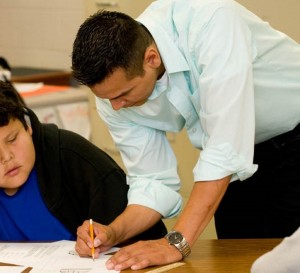In education, Response To Intervention (commonly abbreviated RTI or RtI) is a method of academic intervention used in the United States which is designed to provide early, effective assistance to children who are having difficulty learning. Response to intervention was also designed to function as one part of a data-based process of identifying learning disabilities. This method can be used at the group and individual level. The RTI method has been developed by proponents as an alternative to identifying learning disabilities with the ability-achievement discrepancy model, which requires children to exhibit a discrepancy between their ability, often measured by Intelligence Quotient|IQ testing and academic achievement as measured by their grades and standardized testing. Further, proponents claim that the RTI process brings more clarity to the Specific Learning Disability (SLD) category of the Individuals with Disabilities Education Improvement Act (IDEA 2004) while opponents claim that RTI does not identify SLD (usually called LD) but instead identifies low achieving students. Proponents of RTI sometimes state that SLD (LD) has been referred to as a residual category for children with moderate learning problems.[1] While opponents of RTI view it as a method of identifying LD, and others view LD as a valid construct supported by practice and more recent scientific studies of the functioning of the brain.
RTI seeks to prevent academic failure through early intervention, frequent progress measurement, and increasingly intensive research-based instructional interventions for children who continue to have difficulty. Students who do not show a response to effective interventions are likely (or, more likely than students who respond) to have biologically-based learning disabilities and to be in need of special education.[2]
The traditional means to identify children with learning disabilities has been through the discrepancy model which looks at the difference between ability as sometimes measured by a child’s scores on both subsets of an IQ evaluation (such as the Wechsler Intelligence Scale for Children (WISC-IV) and an evaluation of achievement as indicated by the student’s grades, teacher evaluations and testing (such as the Wechsler Individual Achievement Test (WIAT)[3] There are criticisms associated with the discrepancy model, for example, that the model does not allow for early identification and intervention.[4] Another criticism includes the lack of a universal definition or formula for identifying a significant IQ-Achievement discrepancy.[5] For children with learning disabilities, proponents claim that RTI may assist schools in avoiding the so-called “wait-to-fail” method by providing intervention as soon as children exhibit difficulty, while opponents of RTI claim that RTI may delay the specialized instruction and the provision of legal rights to students and their parents provided by IDEA only after a parent or teacher formally requests an evaluation under IDEA.

